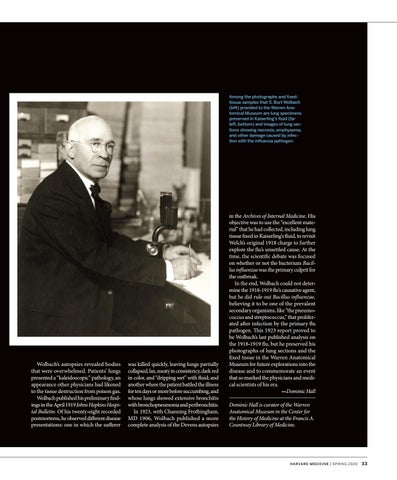Among the photographs and fixedtissue samples that S. Burt Wolbach (left) provided to the Warren Anatomical Museum are lung specimens preserved in Kaiserling’s fluid (far left, bottom) and images of lung sections showing necrosis, emphysema, and other damage caused by infection with the influenza pathogen.
Wolbach’s autopsies revealed bodies that were overwhelmed. Patients’ lungs presented a “kaleidoscopic” pathology, an appearance other physicians had likened to the tissue destruction from poison gas. Wolbach published his preliminary findings in the April 1919 Johns Hopkins Hospital Bulletin. Of his twenty-eight recorded postmortems, he observed different disease presentations: one in which the sufferer
was killed quickly, leaving lungs partially collapsed, lax, meaty in consistency, dark red in color, and “dripping wet” with fluid; and another where the patient battled the illness for ten days or more before succumbing, and whose lungs showed extensive bronchitis with bronchopneumonia and peribronchitis. In 1923, with Channing Frothingham, MD 1906, Wolbach published a more complete analysis of the Devens autopsies
in the Archives of Internal Medicine. His objective was to use the “excellent material” that he had collected, including lung tissue fixed in Kaiserling’s fluid, to revisit Welch’s original 1918 charge to further explore the flu’s unsettled cause. At the time, the scientific debate was focused on whether or not the bacterium Bacillus influenzae was the primary culprit for the outbreak. In the end, Wolbach could not determine the 1918-1919 flu’s causative agent, but he did rule out Bacillus influenzae, believing it to be one of the prevalent secondary organisms, like “the pneumococcus and streptococcus,” that proliferated after infection by the primary flu pathogen. This 1923 report proved to be Wolbach’s last published analysis on the 1918-1919 flu, but he preserved his photographs of lung sections and the fixed tissue in the Warren Anatomical Museum for future explorations into the disease and to commemorate an event that so marked the physicians and medical scientists of his era. —Dominic Hall Dominic Hall is curator of the Warren Anatomical Museum in the Center for the History of Medicine at the Francis A. Countway Library of Medicine.
HARVARD MEDICINE | SPRIN G 2020
33





